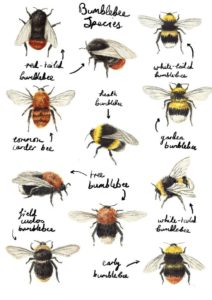BEES
There are over 200 types of Bees in the UK, including 25 types of bumblebees! We’ve listed some of the most common here. Different types of bee may require different treatment methods.
Note: We do not apply bee treatments unless there’s a serious threat to human life. 25% of all bee types are endangered.
Click for the BRITISH BUMBLE BEE IDENTIFICATION GUIDE
Bumblebees
They aren’t easily confused with any other bee. They are rounder, larger and furrier and come with a variety of coloured stripes across the end of their tails. Nesting sites are normally found underground in abandoned burrows, bird boxes, under the decking, or in the compost bin.
Bumblebees are social insects: they live in a colony with a queen and her offspring (the workers). Bumblebees have an annual lifecycle, with new nests being started each spring by queens. The queen bumblebees are very large, and from February onwards can be seen feeding on flowers such as willow catkins, bluebells and lungwort, or flying low over the ground searching for a nest site.
Some species prefer to nest underground in abandoned burrows of rodents, while others nest just above the ground in dense grass or leaf-litter. The queen stocks her nest with pollen and nectar and lays her first batch of eggs. She incubates them much as a bird would, sitting on the eggs while shivering her flight muscles to produce warmth.
When the eggs hatch the legless grubs consume pollen and nectar, grow rapidly, and pupate after a few weeks. A few days later the first workers hatch from their pupae and begin helping their queen, expanding the nest and gathering food. By mid-summer nests of some species can contain several hundred workers. At this point, the queen starts laying both male and female eggs.
The females are fed extra food and become future queens. Both males and new queens leave the nest to mate, and the new queens burrow into the ground to wait until the following spring. The males, workers, and the old queen die off in the autumn, leaving the nest to decay.
Tree bees
A recent addition to the UK’s fauna. Their banding is unique amongst the UK species. The thorax is tawny to reddish brown, the abdomen is black and tail is white. Fresh drones have a patch of yellowish facial fur, but this wears off with time. Queens vary significantly in size, and workers are normally quite small.
Some traits of tree bees can be a cause of concern, but there is nothing to worry about. Commonly they establish a nest in bird boxes, or in parts of buildings, and may cause concern through apparent high level of nest flight activity due to ‘nest surveillance’ by drones, and the sound of bee chatter/activity heard through the ceiling are all signs of activity.
Solitary/Masonry bees
As the name suggests, they are solitary insects, and you’ll rarely find them occurring in large numbers. They have a reddish-brown bottom and black body. You’ll see these small bees popping in and out of the wall or very small holes in the ground.
They nest in a wide range of cavities and have the ability to build nests by tunnelling through soft brick mortar, or exploiting pre-existing gaps left unrepaired. They do not cause a problem to your property from a structural point of view.
Honeybees
Providers of honey and almost universally viewed with affection in the UK. They rarely present problems as pests, however, feral swarms can set up home in undesirable places such as chimneys and wall cavities. Honey bees are small and vary in colour from golden brown to almost black.
The most common scenario in which you may become concerned is when they swarm. Typically these intimidating swarms will first set up a temporary camp somewhere nearby, such as a tree branch, fence post and even cars. In almost all cases the swarm will take off again within a day or two to occupy a most suitable permanent home elsewhere.
How to get rid of bees
Contrary to popular belief bees aren’t protected and can be treated, however, they are endangered so we’d always recommend exploring all other avenues before considering eradication.
Leave them alone
Bees don’t cause any problems to your property, and nor are you in danger of being stung if they are left alone and unprovoked. After the summer season, most bees will go away and not return to the nesting site the following year. By the time a colony has become obvious its activity will be about to decline naturally. Generally, colonies formed in spring usually decline naturally by late July, if not sooner. Therefore If at all possible always bee nests alone to thrive as their presence is actually beneficial for gardeners and their crop.
Relocation
If a nest is outside or underground then there shouldn’t be a reason to really move it. In more conventional and accessible places such as bushes, trees and sheds, then contacting a local beekeeper or pest controller to relocate the nest is an option. If you suspect you have honeybees and they are causing you problems then we would recommend you use a swarm collector from the British Bee Keepers Association or getting in touch with the Tree Bee Society. In most cases, they will come and collect the swarm free of charge.
Only if the location of a nest is dangerous and removal not possible, should the next step be an option.



